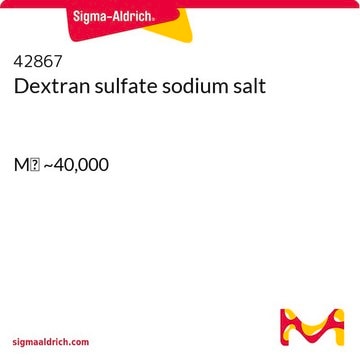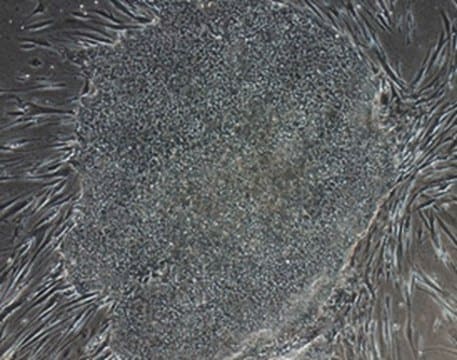70967
GeneJuice® Transfection Reagent
Non-lipid based chemical transfection reagent optimized for maximum transfection efficiency, ease-of-use, and minimal cytotoxicity on a wide variety of mammalian cells.
Synonim(y):
GeneJuice Transfection, Transfection Reagent
About This Item
Polecane produkty
Poziom jakości
Postać
liquid
producent / nazwa handlowa
Novagen®
warunki przechowywania
OK to freeze
metody
transfection: suitable
Warunki transportu
wet ice
temp. przechowywania
2-8°C
Powiązane kategorie
Opis ogólny
Stuart Rulten. Research Fellow. University of Sussex
""Since we have been working with GeneJuice, we have saved a lot of time and money!""
Dr. Andrea Kress, Institute of Clinical and Molecular Virology, Erlangen, Germany
""I find that Genejuice works for a multitude of cell types with minimal optimization""
Caitriona Marie Lyons. PhD Student. University College Cork, Ireland
Transfection is the process by which nucleic acids are introduced into mammalian cells. GeneJuice Transfection Reagent is a proprietary formulation optimized for maximal transfection efficiency, ease of use, and minimal cytotoxicity for mammalian cells. Whereas many available transfection reagents are based on cationic lipid formulation, GeneJuice Transfection Reagent is composed of a nontoxic cellular protein and a small amount of a novel polyamine. GeneJuice Transfection Reagent enables highly efficient DNA transfer in both stable and transient transfections of eukaryotic cells and is ideal for high-throughput transfections in a multi-well plate format. The unique composition is compatible with both serum-containing and serum-free media, making media changes unnecessary during transfection experiments. Genejuice is a superior alternative to a wide variety of other techniques including calcium phosphate coprecipitation, electroporation, microinjection, biolistic particle delivery, lipofection, and complex formation with DEAE-dextran. The 1 ml size provides enough reagent to perform up to 500 transfections in standard 35 mm plates.
Cell lines transfected with GeneJuice® Transfection Reagent
| Cell Lines: | Primary Cells: | ||||
|---|---|---|---|---|---|
| 10T1/2 293T 3T3 NIH 3T3 Swiss 3T3-L1 A204 A431 A549 alpha TC1-6 AR 42J As4.1 AtT-20 B50 BC-1 BC-2 BC3 BCBL BHK-21 C3H/10T1/2 C6 C2C12 | Caco-2 Caki-1 Calpan-1 Calu-1 Calu-6 CCL-131 CFPAC-1 Chang Liver CHO CHO-7 CHO-IR CHO-K1 COS-1 COS-7 CS-1 CV-1 Daudi DDTI MF-2 DT40 ECV304 EL4 | ES-E14TG2a EVSCC17M H9c2 HCT-116 HEK293 HeLa HeLa B HeLa T4 Hep 3B2.1-7 HepG2 Hepa 1-6 Ht-29 HTB-37 HTB-45 Huh-7 HUVEC IC21 IEC-6 JEG-3 Jurkat KB | L57-3-11 L-6 L-929 MA-10 McA-RH7777 MCF-7 MCF-10-2A MDCK Melanocyte MG-63 Neuro 2A Neuroblastoma NRK NT2/D1 OV-1063 OVCAR3 P4 P19 PC12 PA317 PAM212 | PS-1 R2C RAW 264.7 RBL-2H3 RMP-41 SAOS-2 SC-1 Schneider line2 SK-N-MC SK-N-SH SKOV3 STO SW-480 SW-837 T3M4 TM4 U937 UCD Vero | Aortic smooth muscle cells Astrocytes Angioblasts Chondrocytes Chromaffin cells Epithelial cells: mammary prostate tracheal Fibroblasts Keratinocytes |
Cechy i korzyści
- Highly efficient DNA transfer for both stable and transient transfections
- Compatibility with both serum-containing and serum-free media
- Simple protocolno need for media changes
- Ideal for high-throughput transfection in a multi-well plate format
- Ideal for retrovirus production for T-cell transduction
- Works for a multitude of cell types with minimal optimization
- Provides higher transfection efficiency and lower cytotoxicity than reagents from other suppliers
- The 1 ml size provides enough reagent to perform up to 500 transfections in standard 35 mm plates
Ostrzeżenie
Uwaga dotycząca przygotowania
Inne uwagi
Informacje prawne
Hasło ostrzegawcze
Danger
Zwroty wskazujące rodzaj zagrożenia
Zwroty wskazujące środki ostrożności
Klasyfikacja zagrożeń
Eye Irrit. 2 - Flam. Liq. 2
Kod klasy składowania
3 - Flammable liquids
Klasa zagrożenia wodnego (WGK)
WGK 1
Temperatura zapłonu (°F)
67.1 °F - Information taken from reference works and the literature.
Temperatura zapłonu (°C)
19.5 °C - Information taken from reference works and the literature.
Certyfikaty analizy (CoA)
Poszukaj Certyfikaty analizy (CoA), wpisując numer partii/serii produktów. Numery serii i partii można znaleźć na etykiecie produktu po słowach „seria” lub „partia”.
Masz już ten produkt?
Dokumenty związane z niedawno zakupionymi produktami zostały zamieszczone w Bibliotece dokumentów.
Klienci oglądali również te produkty
Powiązane treści
Major technological advances have made the production of monoclonal antibodies quicker and more efficient. There are three established platforms for antibody discovery. We offer reagents for production of monoclonal antibody libraries using each of these techniques.
Znaczący postęp technologiczny sprawił, że produkcja przeciwciał monoklonalnych stała się szybsza i bardziej wydajna. Istnieją trzy ustalone platformy do odkrywania przeciwciał. Oferujemy odczynniki do produkcji bibliotek przeciwciał monoklonalnych przy użyciu każdej z tych technik.
Nasz zespół naukowców ma doświadczenie we wszystkich obszarach badań, w tym w naukach przyrodniczych, materiałoznawstwie, syntezie chemicznej, chromatografii, analityce i wielu innych dziedzinach.
Skontaktuj się z zespołem ds. pomocy technicznej

















